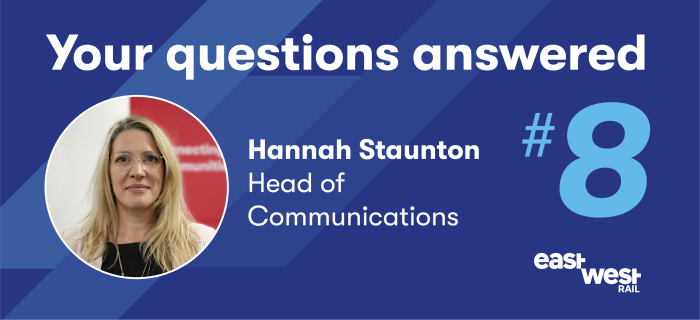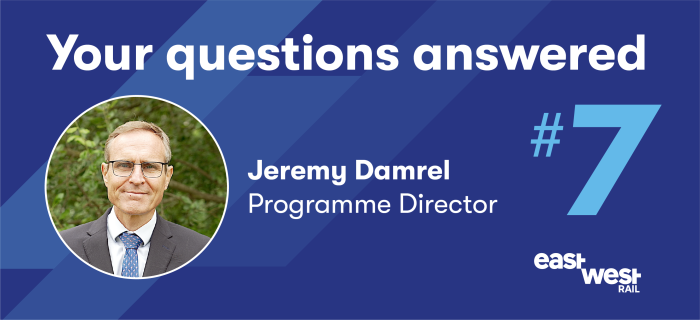About this route update announcement
In 2021, we consulted with people on proposals for East West Rail and since then we’ve continued to have conversations and build relationships with communities, businesses and other stakeholders across the route.
Listening to and understanding the views of people living and working in the communities EWR would serve is fundamental to the way the new rail connection is designed, built and operated.
This route update is the next major milestone in the planning process and covers three key elements: route preferences, route-wide matters and the next steps in the Project.
It outlines the range of benefits EWR would bring to the region including opening up new journeys, cutting travel times, easing congestion on local roads and bringing more jobs within reach of local people. The route update announcement also underlines the detailed Strategic Case for EWR and its ability to unlock growth potential both in the region and the UK as a whole.
What we've done since 2021
In 2021 we consulted with the public on nine potential route alignment options for the proposed railway line between Bedford and Cambridge. We also wanted to understand people’s views on the entire route between Oxford and Cambridge.
The quality and volume of feedback was excellent. We received almost 10,000 responses and, within these, over 160,000 individual matters were raised.
Since the consultation closed, we’ve reviewed this feedback and used it to help guide our developing plans to design a railway that best meets the needs of communities across the entire region.
The Route Update Report describes how proposals for EWR have developed since our second non-statutory public consultation in 2021, and what our preferred plans for certain sections of the railway are.
In December 2021, the Department for Transport (DfT) and EWR Co agreed that we should set up the Affordable Connections Project (ACP). This was driven by two factors. First, a drive for lower costs, reflecting the impacts of Covid-19; and secondly a focus on ensuring the benefits could be supported through local leadership.
The ACP therefore considered whether there remained a strategic case for investing in EWR and if there were solutions which could deliver the majority of the expected benefits of EWR at a lower capital cost to the taxpayer.
Full details of the ACP can be found in our Economic and Technical Report.
Preferred Route Alignment
Based on our work since 2021, we’ve updated our preferred route alignment. Below you can see the latest map of the proposed East West Rail route.


Why is the southern approach to Cambridge the preferred option?
This video is a short animation explaining the considerations around the approach to Cambridge and serving the Cambridge Biomedical Campus.
Watch videoWhy an additional two tracks are needed north of Bedford
This video is a short animation explaining the considerations around serving central Bedford and the constraints using the existing Midland Main Line north of Bedford.
Watch video
Our proposals at a glance
To help you get an understanding of this route update at a glance, we’ve outlined the key updates below.

Increasing rail capacity between Oxford and Bicester
Oxford station does not yet provide enough capacity to accommodate the full set of planned EWR services. Network Rail is already planning work at Oxford station both in the short and medium term, and we’re working with them to ensure an integrated solution that both supports EWR services and wider growth ambitions in the area. To be sure that EWR could operate should the full Network Rail schemes not be completed as expected, we’re also working with them on a number of EWR specific enhancements as a contingency.
At Oxford Parkway and Bicester Village stations, we’re exploring whether further work would be needed to accommodate EWR services.

Maintaining connectivity at London Road in Bicester
London Road level crossing in Bicester is a vital route for people to get into the town centre on foot, by bicycle, public transport and car. Once all EWR services are introduced on the line, the barriers are expected to be down for a significant portion in every hour.
At the 2021 consultation we suggested six concepts, and thanks to the feedback we received and ongoing work, we’ve been able to rule out five of these. We’ve yet to confirm a preferred solution as we’re continuing to consider options for the crossing that keep the town connected and minimise inconvenience. As part of this, we’re considering how the crossing could be safely kept open for local traffic.

Improving services and reducing disruption along the Marston Vale
At the 2021 consultation we explained that it’s not possible to introduce a fast and frequent service between Oxford and Cambridge without making a significant investment in the Marston Vale Line (MVL). Also, the current infrastructure has not had significant upgrades for decades, which has affected reliability. The communities it serves have grown considerably over time and lack the reliable connections they need to centres of education and employment in Bedford, Milton Keynes and beyond.
We’ve looked further at the potential number of passengers that could use stations on the MVL and we believe that three trains per hour (tph) would meet this need, rather than the four to five tph that we set out previously. At the next stage we’ll consider all three services together in identifying the best timetable and stopping pattern for communities along the line of the railway.
This change in frequency allows us to maintain the benefits of EWR, and requires less construction work to upgrade the line, which would reduce disruption to local communities and passengers, as well as reducing cost.
We’re also suggesting capping the line speed below the 100mph originally proposed, but above the current speed of 60mph. This would reduce disruption in residential areas, but still provide a faster service than currently available.
Combined with our updated view on frequency, the lower line speed means that some level crossings – for example at Woburn Sands and Lidlington – could still meet the appropriate safety standards and so could be retained. This would be one of the many ways we’d maintain local connectivity across and between communities.
The reinstatement of the second track at Fenny Stratford is still required, as is the short length of additional track to dual track the railway in the Bedford St Johns area.

A new station for Bedford Hospital
The railway at Bedford St Johns is unable to accommodate the proposed EWR train services, as there’s only one track on this part of the railway and only one platform at Bedford St Johns station, which limits capacity. The track is also on a very tight curve, limiting the train speed to 15mph.
We propose to relocate the existing Bedford St Johns station closer to Bedford Hospital. This would provide a better location that’s more convenient for patients, hospital staff and visitors, while also allowing us to improve the alignment of the railway into Bedford station.

Serving central Bedford and connecting with the wider rail network
Bedford station is already an important transport hub for the region, providing a gateway into the town centre and easy connections to Thameslink and East Midlands Railway (EMR) services on the Midland Main Line (MML). Introducing EWR services would strengthen the hub and support local aspirations for more jobs, prosperity and growth. Improvements to Bedford station would contribute to the regeneration of the area immediately around the station, as well as the centre of Bedford.
We looked again at alignments that pass to the south of the town or re-use parts of the former alignment of the closed Varsity Line, but these alternatives have significant environmental impacts and cause loss of public open space. For example, a route re-using the former Varsity Line in Bedford would pass through Priory Park, which has protected status. Therefore, we’ve concluded that the preferred alignment from the 2021 consultation, passing through Bedford station and to the north of the town along the MML, remains the best option for Bedford.
We propose to redevelop the station to take account of the required capacity and new infrastructure required for EWR services and in doing so help support the local authority’s plans for regeneration in the Station Quarter.
After extensive work to test whether we can run services on the existing MML without building additional tracks, we’ve concluded that we need an additional two tracks north of the existing Bedford station. This is to ensure EWR could provide a reliable service which does not conflict with other trains.
To construct these new tracks, we’d need to acquire some properties near the current railway boundary. At the last consultation we thought we might need to acquire up to 97 residential properties, but we’ve continued to challenge the design in this area and believe this figure is now reduced by a third, to 65. Even though we’ve reduced the number of impacted properties, we continue to look for ways to further limit the impact of EWR in this area, and we’re launching a scheme to help homeowners in this area with immediate effect.
Further information on the Proposed Need to Sell Property Scheme can be found on our dedicated Need to Sell page eastwestrail.co.uk/needtosell

Connecting Bedford and Cambourne
To deliver a service between Bedford and Cambourne, we would need to build a new railway in this section. In the 2021 consultation we presented a range of possible route alignment options for where the railway line could be located.
Using feedback from the last consultation and further studies, we’ve concluded that one of our emerging preferences in 2021, Alignment 1, provides the best option for the majority of its length. We believe the identified environmental impacts can be mitigated and that this alignment would have the least visual impact for local communities. It would also serve a new station at Cambourne North, maximising economic opportunities for the town.
Our analysis also showed us that a station near Tempsford (part of Alignment 9) would have greater advantages compared to a station at St Neots South (part of Alignment 1). A Tempsford station would be better located to enable a new community to grow, including opportunities to improve biodiversity and give more people access to green spaces. There would also be more opportunity at Tempsford to design the railway so that it could be at the centre of the local travel network including good walking, wheeling for those using mobility aids and cycling routes.
Considering the above points, we’ve concluded that the best option is to follow the route of Alignment 1 for most of the route, but we have an emerging preference for a local variation so we can provide a new station at Tempsford. We refer to this new route as Alignment 1 (Tempsford variant).

Connecting more people with opportunities in Cambridge
In addition, there are three times as many jobs within walking distance of Cambridge South station compared to Cambridge North. The existing transport network is also more congested in the south, making it harder for existing employees to get to work, and limiting further job creation.
We considered whether it would be possible to serve Cambridge South station taking the northern approach but concluded that this would reduce the frequency of trains and extend journey times, including likely requiring passengers to change trains, to an unacceptable level. It would make it harder for people living in Bedford, the Marston Vale or near St Neots/Tempsford to access the jobs at the Biomedical Campus – and therefore it wouldn’t deliver the economic opportunity that underpins the case for EWR.
Having reviewed all the consultation feedback and following this extensive further study our conclusion remains that approaching Cambridge from the south is the best solution for the city, the region and – given the global opportunity at the Biomedical Campus – for the whole of the UK too. Approaching Cambridge from the south also means that EWR does not take up the existing capacity on the rail network north of the city, leaving this option available for others in the future.

Reducing the impact of embankments and viaducts
During the 2021 consultation, we presented outline details about where the new railway might need to be ‘on embankment/viaduct’ along its southern approach to Cambridge and presented the ‘reasonable worst case’ scenario. Our work since the consultation has helped us to identify potential opportunities to reduce or remove viaducts and embankments. We believe we could remove or reduce the height of approximately half the embankments or viaducts (by length) compared to what was shown at the consultation. This work will be developed further and we’ll provide details for comment at the statutory consultation.

Powering the trains
We’re focused on delivering a net zero carbon railway. We’re continuing to evaluate a range of technological solutions for powering our trains and we’ll share more information at the statutory consultation.

Considering freight
EWR’s primary purpose is to support economic growth as a passenger railway – to connect lives and unlock opportunities. Alongside this, and noting that some freight already runs on sections of our route, we’re considering whether EWR might also support new freight opportunities as part of delivering wider economic growth. These opportunities would need to be balanced against the required investment and also the impact to local communities. When it opens, our railway is likely to enable up to two additional freight trains per day in each direction from Oxford to Bletchley, and another two from Cambridge to Oxford. This would take nearly 70,000 HGV journeys off the road each year, and the volume of additional freight trains would be unlikely to exceed this level without significant further investment, both on EWR and elsewhere on the rail network.
The Proposed Need to Sell Property Scheme
As East West Rail progresses we'll need to survey, access and sometimes buy land to build and operate the railway. We know some of the latest proposals for East West Rail may affect people's homes and businesses.
After listening to community feedback, we've launched the Proposed Need to Sell Property Scheme.
This will help people with a compelling reason to sell, but who can only do so at a far lower value due to East West Rail. Eligible owners can apply for their property to be bought at its unaffected market value.
Need to Sell Property Guide (Download PDF)
Need to Sell Application Form (Download PDF)
Further information on the Proposed Need to Sell Property Scheme can be found on a dedicated page by clicking the link below.
Learn moreFactsheets
-
Accessibility and inclusion
-
Active travel
-
How you can apply to the NTS Property Scheme
-
How we make an offer to buy your property
-
Approaching Cambridge
-
Approach to powering EWR trains
-
Assessment factors
-
Connecting with Bedford
-
Connecting Bedford and Cambourne
-
Benefits of East West Rail
-
Embankments and viaducts
-
Introducing the route update
-
Our approach to freight
-
Response to 2021 Consultation
-
Our approach to land and landowners
-
Marston Vale Line
-
The Affordable Connections project
-
Our approach to the environment
-
Why two additional tracks are needed north of Bedford
Maps
-
Approaching Cambridge
-
Alignments 1 & 9 – Tempsford variant
-
Approach to Bedford, Bedford St Johns & Bedford Station
-
Area around London Road level crossing
-
Bedford to Cambourne
-
East West Rail preferred route
-
Existing route from Oxford Parkway to Bicester
-
Existing route from Oxford station to Oxford Parkway
-
Route from Bletchley to Bedford
-
Potential locations for Bedford St Johns station
-
Potential track changes in Oxford
-
Properties likely to be directly affected in the Poets area of Bedford
-
Proposed train service pattern – Southern approach to Cambridge
-
Varsity Hybrid alignments – Environmental risks/constraints
These maps do not show the full geographical detail in each area as, at this stage in the design process, they are produced only to help people orientate themselves when looking at the proposed route.
If you'd prefer to view these maps in a different style, which shows more information at the given scales, then these are available here.
Land & property
We have a dedicated land and property section of the website where there are several resources to provide further information for homeowners and landowners.
Here you will also find details of how to get in touch with the EWR Land and Property team.
Further information on land and property can be found on a dedicated page by clicking the link below.
Learn moreDCO process
East West Rail is a nationally significant project, which means we are required by law to make an application for a Development Consent Order (DCO) to build and operate the railway.
The findings from the statutory consultation currently planned for the first half of 2024 will be included in our DCO application, along with designs, studies, technical information and other evidence.
To find out more about how it works, head over to this Q&A.
Learn moreWe’re here to help
If you have any questions about the route update or the East West Rail project more broadly, please get in touch through the following contact channels:
Email us: [email protected]
Write to us: Freepost EAST WEST RAIL
Call us: 0330 1340067















